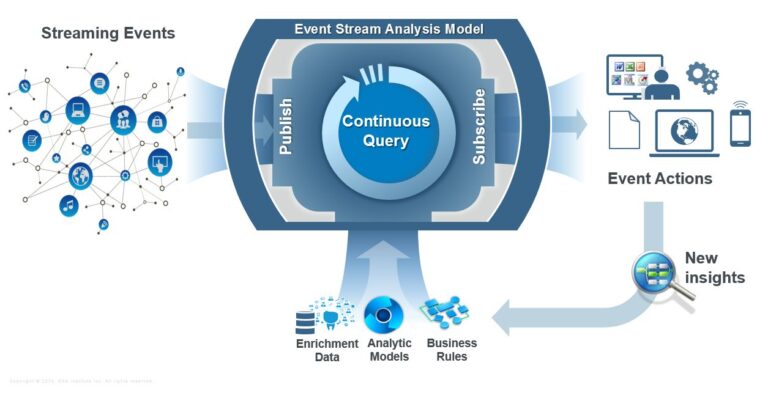Event streaming is revolutionizing how businesses handle data in real-time, but what exactly is event streaming? Understanding the essence of event streaming, its significance, and its implications in today’s data-driven world is crucial for any organization looking to stay ahead in the digital age. In this comprehensive guide, we will delve deep into what event streaming entails, how it differs from traditional batch processing, and why it has become a game-changer for industries across the board. Join us as we unlock the power of event streaming and explore its capabilities in transforming data processing, enabling instant insights, and paving the way for innovative solutions that drive business success.
Introduction to Event Streaming
Event streaming is a real-time data processing method that involves the continuous transmission of data records from sources to targets. By leveraging event streaming platforms, organizations can capture, process, and analyze data in motion, enabling instant insights and actionable outcomes. This technology plays a crucial role in driving real-time decision-making and powering various applications across different industries.
Key Components of Event Streaming
Event Brokers: These are the centralized hubs that facilitate the seamless flow of data between producers and consumers.
Streaming Data Processors: These components help in transforming, enriching, and aggregating the incoming data streams in real-time.
Advantages of Event Streaming
Implementing event streaming architectures offers scalability and resilience to handle large volumes of data efficiently.
Event streaming enables organizations to derive valuable insights from data as it flows, leading to quicker responses and better decision-making processes.

Understanding the Basics of Event Streaming
Event streaming is a data processing technique that involves the continuous transmission of data records to processing systems. It enables real-time analytics, monitoring, and decision-making based on incoming data streams, offering insights into events as they occur.
The Role of Data Streams
Event streaming platforms like Apache Kafka and Amazon Kinesis play a crucial role in managing the flow of event data. These platforms help in storing, processing, and distributing data streams efficiently.
Event-Driven Architecture
Event streaming relies on event-driven architecture, where systems respond to events triggered by changes in data. This architecture allows for decoupled systems and seamless scalability, making it ideal for dynamic applications.

Benefits of Event Streaming
Event streaming offers numerous benefits for businesses looking to harness real-time data insights. By leveraging event streaming technology, organizations can unlock a competitive edge and drive strategic decision-making.
Real-time Data Processing
Event streaming enables the processing of data in real time, allowing businesses to react instantly to changing conditions and trends. This capability ensures that organizations stay agile and responsive in a fast-paced environment.
Improved Customer Engagement
With event streaming, businesses can analyze customer behavior instantly, enabling personalized interactions and targeted marketing campaigns in 2022. This leads to enhanced customer satisfaction and loyalty.
Use Cases of Event Streaming
Event streaming is a powerful technology with numerous applications across various industries. Let’s explore some of the key use cases:
Data Analytics
Implementing event streaming for real-time data analytics allows businesses to make critical decisions based on the most up-to-date information available. This is particularly beneficial in scenarios where immediate insights are crucial for operations.
Monitoring and Alerting
Event streaming enables continuous monitoring of systems and processes, triggering alerts in real-time when predefined thresholds are breached. This proactive approach helps organizations address issues swiftly, reducing downtime and enhancing overall efficiency.
IoT Applications
Integrating event streaming with IoT devices facilitates the seamless collection and processing of sensor data, enabling the creation of responsive and connected ecosystems. This enhances automation and enables predictive maintenance in IoT environments.
Cybersecurity
Utilizing event streaming for cybersecurity applications enables organizations to detect and respond to security threats in real-time. By analyzing event streams for anomalies and patterns, potential breaches can be identified and mitigated promptly.

Implementing Event Streaming in Practice
Implementing event streaming in practice involves setting up a robust architecture to handle real-time data processing efficiently. Organizations leverage event streaming to capture, process, and analyze data as it is generated.
Choosing the Right Event Streaming Platform
When implementing event streaming, the first step is selecting the appropriate event streaming platform. Popular choices include Apache Kafka, Amazon Kinesis, and Confluent.
It is crucial to evaluate the scalability and compatibility of the platform.
Designing Event-Driven Architecture
Designing an event-driven architecture is essential for effective event streaming. This involves identifying events, defining producers and consumers, and establishing event schemas.
Utilize event sourcing and event processing patterns for optimal results.
Challenges and Solutions in Event Streaming
Event streaming faces several challenges in its implementation, ranging from scalability issues to data consistency problems.
Scalability
One of the major challenges in event streaming is ensuring scalability to handle a large volume of events in real-time. Solutions: leveraging cloud-based services for elastic scaling.
Data Consistency
Ensuring data consistency across distributed systems can be a challenge in event streaming architectures. Solutions: implementing idempotent processing and transactional updates.
Latency
High latency can hinder real-time processing in event streaming. Solutions: optimizing data pipelines and utilizing in-memory caching.
Best Practices for Effective Event Streaming
In the realm of modern data processing, understanding what is event streaming is crucial for businesses looking to unlock the power of real-time data insights. To ensure effective event streaming, there are several best practices that organizations should follow to optimize their data processing strategies.
Utilize Scalable and Reliable Event Streaming Platforms
Choosing a scalable and reliable event streaming platform is essential for ensuring uninterrupted data flow. Platforms like Apache Kafka or Amazon Kinesis provide the necessary infrastructure to handle large volumes of real-time data streams.
Implementing proper monitoring tools for real-time data processing can help organizations identify and mitigate potential issues before they impact operations.
Ensure Data Quality and Consistency
Ensuring data quality and consistency is paramount in event streaming. Organizations should define clear data validation processes to filter out erroneous or redundant data points.
- Implement data enrichment techniques to enhance the value of streaming data.
- Regularly validate and clean incoming data streams to maintain data integrity.
Frequently Asked Questions
-
- What is event streaming?
- Event streaming is a technology that involves the continuous transmission and processing of data in real time as events occur.
-
- How does event streaming work?
- In event streaming, data is generated as continuous streams of events, which are then processed, analyzed, and acted upon in real time by various applications.
-
- What are the benefits of using event streaming?
- Event streaming enables organizations to react instantly to events, make data-driven decisions in real time, and build scalable and resilient systems.
-
- What are some common use cases for event streaming?
- Event streaming is commonly used in applications such as real-time analytics, fraud detection, monitoring, IoT, and more.
-
- What technologies are commonly used for event streaming?
- Popular technologies for event streaming include Apache Kafka, Amazon Kinesis, Apache Flink, and others.
Unlock the Potential of Event Streaming: Closing Thoughts
Event streaming is not just a buzzword; it’s a game-changer in the world of real-time data processing. In this comprehensive guide, we’ve delved into what event streaming is and how it revolutionizes data management and analytics. By leveraging event streaming platforms like Apache Kafka or Amazon Kinesis, businesses can unlock the power of instant data processing, seamless communication, and improved decision-making.
Understanding what event streaming is allows organizations to harness the continuous flow of data, enabling them to respond swiftly to changing trends and customer demands. Embracing event streaming is not just a trend but a necessity in today’s fast-paced digital landscape. So, dive into the world of event streaming and propel your business towards success!

